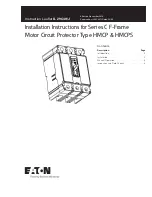
to GOOSE is part of the standard. Disturbance files uploading
is provided.
Serial communication, LON
Existing stations with ABB station bus LON can be extended
with use of the optical LON interface. This allows full SA
functionality including peer-to-peer messaging and
cooperation between existing ABB IED's and the new IED
670.
SPA communication protocol
A single glass or plastic port is provided for the ABB SPA
protocol. This allows extensions of simple substation
automation systems but the main use is for Substation
Monitoring Systems SMS.
IEC 60870-5-103 communication protocol
A single glass or plastic port is provided for the
IEC60870-5-103 standard. This allows design of simple
substation automation systems including equipment from
different vendors. Disturbance files uploading is provided.
DNP3.0 communication protocol
An electrical RS485 and an optical Ethernet port is available
for the DNP3.0 communication. DNP3.0 Level 2
communication with unsolicited events, time synchronizing
and disturbance reporting is provided for communication to
RTUs, Gateways or HMI systems.
Multiple command and transmit
When 670 IED's are used in Substation Automation systems
with LON, SPA or IEC60870-5-103 communication protocols
the Event and Multiple Command function blocks are used as
the communication interface for vertical communication to
station HMI and gateway and as interface for horizontal peer-
to-peer communication (over LON only).
IEC 62439-3 Parallel Redundant Protocol
Redundant station bus communication according to IEC
62439-3 Edition 1 and IEC 62439-3 Edition 2 are available as
options in 670 series IEDs. IEC 62439-3 parallel redundant
protocol is an optional quantity and the selection is made at
ordering. Redundant station bus communication according to
IEC 62439-3 uses both port AB and port CD on the OEM
module.
Select IEC 62439-3 Edition 1 protocol at
the time of ordering when an existing
redundant station bus DuoDriver installation
is extended.
Select IEC 62439-3 Edition 2 protocol at
the time of ordering for new installations
with redundant station bus.
IEC 62439-3 Edition 1 is NOT compatible
with IEC 62439-3 Edition 2.
12. Remote communication
Analog and binary signal transfer to remote end
Three analog and eight binary signals can be exchanged
between two IEDs. This functionality is mainly used for the
line differential protection. However it can be used in other
products as well. An IED can communicate with up to 4
remote IEDs.
Binary signal transfer to remote end, 192 signals
If the communication channel is used for transfer of binary
signals only, up to 192 binary signals can be exchanged
between two IEDs. For example, this functionality can be
used to send information such as status of primary
switchgear apparatus or intertripping signals to the remote
IED. An IED can communicate with up to 4 remote IEDs.
Line data communication module, short range LDCM
The line data communication module (LDCM) is used for
communication between the IEDs situated at distances <110
km or from the IED to optical to electrical converter with G.
703 or G.703E1 interface located on a distances <3 km
away. The LDCM module sends and receives data, to and
from another LDCM module. The IEEE/ANSI C37.94 standard
format is used.
13. Hardware description
Hardware modules
Power supply module PSM
The power supply module is used to provide the correct
internal voltages and full isolation between the terminal and
the battery system. An internal fail alarm output is available.
Binary input module BIM
The binary input module has 16 optically isolated inputs and
is available in two versions, one standard and one with
enhanced pulse counting capabilities on the inputs to be
used with the pulse counter function. The binary inputs are
freely programmable and can be used for the input of logical
signals to any of the functions. They can also be included in
the disturbance recording and event-recording functions. This
enables extensive monitoring and evaluation of operation of
the IED and for all associated electrical circuits.
Binary output module BOM
The binary output module has 24 independent output relays
and is used for trip output or any signaling purpose.
Static binary output module SOM
The static binary output module has six fast static outputs
and six change over output relays for use in applications with
high speed requirements.
Binary input/output module IOM
The binary input/output module is used when only a few input
and output channels are needed. The ten standard output
channels are used for trip output or any signaling purpose.
Busbar protection REB670
1MRK505212-BEN E
Pre-configured
Product version: 1.2
ABB
21
Содержание RELION REB670
Страница 1: ...Relion 670 series Busbar protection REB670 Pre configured Product Guide...
Страница 61: ...61...
















































